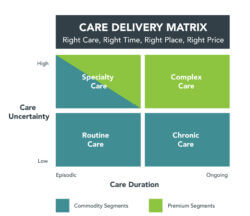September 28, 2021

Healthcare’s Transformative Digital Bazaar: Exchanges, Platforms and Hybrids Oh My!
In the Middle East, thousands of years ago, commerce exploded when intersecting trade routes gave rise to covered markets, known as bazaars or souks. These markets created an exchange for buyers and sellers to execute transactions more efficiently.
That simple model has been wildly successful through centuries, across cultures, for remarkably diverse products and services. Examples include farmers markets, classified ads, message boards and digital exchanges like eBay and Craigslist. The emergence of exchange business models in US healthcare will accelerate consumerism, disrupt status-quo practices and launch a new era of consumer-friendly businesses and services.
 Middle Eastern bazaars thrived because traders gained cost-effective access to consumers, and consumers gained convenient one-stop shopping with multiple offerings and prices. Exchanges reduce transaction friction and costs while facilitating buyer-seller access and enhancing trust. Exchanges disrupt markets by shifting power from producers to consumers and stimulating competition.
Middle Eastern bazaars thrived because traders gained cost-effective access to consumers, and consumers gained convenient one-stop shopping with multiple offerings and prices. Exchanges reduce transaction friction and costs while facilitating buyer-seller access and enhancing trust. Exchanges disrupt markets by shifting power from producers to consumers and stimulating competition.
Modern digital technologies turbocharge these dynamics by significantly increasing access, transparency, efficiency, convenience and transaction speed. Exchange business models have powered the rise of digital market titans, like Uber and Airbnb, that have reconfigured supply-demand relationships throughout the global economy.
US healthcare is late to the game. The following powerful forces have impeded the introduction of exchange business models into healthcare.
- Legislative and regulatory capture by industry incumbents.
- Payer and provider market concentration.
- Complex billing formularies that are hard to understand and easy to manipulate.
- Limited transparency regarding outcomes, prices and customer satisfaction.
- Third-party payment for medical claims complicating buyer-seller dynamics.
- Entrenched myths about care delivery and care quality.
While still formidable, these barriers are now showing signs of giving way. Changing consumer expectations, regulations that encourage consumerism, and the rapid adoption of digital technologies during COVID are facilitating the rise of healthcare exchange businesses. As digital exchanges take hold, healthcare companies must embrace consumerism and deliver value-added services or lose market relevance.
Some incumbent organizations will adapt to exchanges and continue to thrive, but many will not. If the rapid evolution of exchanges in other industries holds true in healthcare, exchange models will transform care delivery quickly and comprehensively.
Exchanges, Platforms and Hybrids
To understand how exchanges unleash market forces, it is helpful to distinguish them from platforms and contrast their approaches to value creation.
Exchanges
Exchanges bring suppliers and consumers together to facilitate easier or better transactions. Pure exchanges have no inventory, do not produce products and do not curate or deliver services. They facilitate exchanges between buyers and sellers in ways that increase transaction ease, transparency and efficiency.
For example, Hotels.com is a digital exchange that facilitates transactions between travelers who need rooms and hotels that supply rooms. Notably, Hotels.com neither owns nor operates hotels. It also does not curate, select or tailor the rooms listed on its service. It simply provides a transparent digital exchange where consumers can select and reserve a room tailored to their needs, preferences and budgets. For their part, hotels gain access to potential customers who reserve rooms with minimal friction.
Platforms
Platform companies bundle goods and services to create seamless offerings for consumers. Platforms resemble exchanges in that they gather supply for consumers and enable easier transactions. However, a platform company can be both a producer and convener of that supply, aligning offerings from both internal and external sources. In addition, unlike exchanges, platform companies curate their offerings to maximize their attractiveness to potential customers.
Target, like other notable retailers, has built a platform that combines brick-and-mortar stores with a digital front door to sell an array of products and services, including its own private-label brands and third-party brands. Its platform extends to in-store partnerships with other retailers, like Apple and CVS. The objective is to capture customers by meeting comprehensive needs for choice, convenience and value.
Although it brings suppliers and consumers together on its digital and brick-and-mortar platform, Target is not an exchange. Suppliers are not “free” to sell their wares, and consumers do not transact directly with suppliers. Instead, Target carefully curates all offerings and aligns supply with demand to enhance value for its consumers.
Exchange-Platform Hybrids
Sometimes exchange businesses evolve into platforms, or platforms incorporate exchange models.
Like exchanges, these hybrid models facilitate transactions between third parties and consumers. Like platforms, they also align and optimize branded and third-party products and services within an integrated customer offering. The larger system meets consumer needs in multiple markets through multiple channels and business models.
Amazon, for example, began as a digital exchange focused on one product (books). As its distribution prowess, market clout and consumer/product-knowledge grew, Amazon evolved its exchange to offer Amazon-branded products and services in competition with products offered by independent suppliers. Over time, it also expanded its offerings of goods and services in many adjacent markets and sectors, creating an increasingly comprehensive system.
Apple, in contrast, built its exchange business (the App Store) to enhance the value of its offerings (primarily computers, smart phones and watches) by facilitating transactions between third-party app developers and consumers. The App store is part of Apple’s broader system of goods, services and delivery channels that include brick-and-mortar stores, a digital front door and select retail partners.
Unlike platforms, hybrid companies do facilitate some direct transactions between suppliers and consumers. Unlike pure exchanges, hybrid companies curate and align their offerings to improve value for customers. They analyze transaction data to enhance innovation and gain competitive advantage over rival businesses and even their own suppliers and partners.
Similarly, many health systems are now building platforms that integrate their own primary, chronic and acute care services with services supplied by third-party vendors in primary, urgent, home and hospice care, as well as imaging, testing and telemedicine services, among others. Their objective, like Target, is to meet comprehensive consumer needs while ensuring quality and controlling costs by aligning supply with demand, curating services and enhancing care coordination.
For example, Hartford Healthcare (HH) is an integrated health system in Connecticut. The company has reorganized its services along the full continuum of care, from acute care to senior living, within a seamless digital platform that consumers can access easily. HH produces some of these services internally. It offers other vital services through strategic partnerships, such as with GoHealth, a national urgent-care provider.
Platforms enhance their value by assembling, curating and aligning the right mix of owned, outsourced or partnered services to create the best offering or experience at the right cost.
Cooperatives
Cooperatives are competing suppliers that join forces to facilitate transactions on a unified exchange for collective benefit.
 For example, agricultural marketing cooperatives pool commodities like grain to facilitate marketing, sales and distribution. This increases market clout and reduces supplier risk and costs. Similarly, regional cab companies formed cooperatives to compete with rideshare exchange businesses like Uber and Lyft. Several entertainment companies co-launched Hulu, a streaming service, to compete with Netflix, the disruptive exchange business.
For example, agricultural marketing cooperatives pool commodities like grain to facilitate marketing, sales and distribution. This increases market clout and reduces supplier risk and costs. Similarly, regional cab companies formed cooperatives to compete with rideshare exchange businesses like Uber and Lyft. Several entertainment companies co-launched Hulu, a streaming service, to compete with Netflix, the disruptive exchange business.
These models (exchanges, platforms, hybrids and cooperatives) often compete for consumers and evolve as market dynamics change. Consumers benefit from the enhanced value, increased access and simplified transactions. They gain power with the ability to make more informed purchasing decisions from a broader selection of competing suppliers.
Exchange-Driven Market Reconfiguration
Exchanges thrive because they reduce the friction that impedes commerce and give consumers more access, selection and control. This unleashes competitive market forces that disrupt status-quo business practices. Exchanges put enormous pressure on suppliers to shift strategies, embrace consumerism and upgrade their offerings.
By capturing consumers through a single powerful channel where they can choose among multiple suppliers, exchanges offer suppliers both carrots and sticks. Participating in the exchange grants easy access to new consumers with minimal transaction friction but generates lower profit margins. Not participating increases the likelihood of losing customers and market share. Digital technologies both amplify the opportunity and the existential threat of more open, transparent and competitive market environments.
 Once they decide to participate in exchanges, suppliers lose market leverage as they compete with other suppliers on a level-field basis. Goods and services become commodities, reducing suppliers’ brand strength and pricing power. Consumers gain power because prices, product/service descriptions and independent ratings are transparent.
Once they decide to participate in exchanges, suppliers lose market leverage as they compete with other suppliers on a level-field basis. Goods and services become commodities, reducing suppliers’ brand strength and pricing power. Consumers gain power because prices, product/service descriptions and independent ratings are transparent.
As exchanges become more robust, consumer activity increases, more suppliers join, and the overall market grows. Consumers gain value at the expense of suppliers. Successful suppliers recover the lost per-unit value through higher-volume sales.
Businesses adapt to this new form of competition by joining exchanges, building their own platforms, cooperating or consolidating with competitors, enhancing their value propositions, and/or developing loyalty programs that attract customers with perks, special offers and amenities.
These strategies are expensive to deploy and not always successful. Marriott, Hyatt and Hilton have adapted to the competitive threat posed by Hotels.com, Airbnb and other hospitality exchange companies by expanding their range of hotel offerings (price points, amenities, decor), building robust loyalty programs and bundling services with affiliated partners (e.g., airlines, rental car companies, retailers). Despite heroic efforts, Borders and numerous other bookstore companies could not compete with Amazon.
Companies that choose not to accommodate exchanges, particularly those offering commodity products and services, often lose market relevance. This prospect should worry incumbent healthcare organizations that offer routine services that are higher-cost, inconvenient and inefficiently delivered.
The Vulnerability of Traditional Healthcare Businesses
Exchanges are most likely to be adopted quickly in markets that have the following characteristics:
- High levels of routine/commodity goods and services
- Low entry barriers for new competitors
- Excessive numbers of inefficient suppliers/providers
- Inefficient and inconvenient service delivery
- High-friction, low-transparency transactions
- Entrenched, status-quo operating practices
- Under-developed technology platforms
- Frustrated customers
Healthcare has these characteristics in abundance.
Among healthcare’s foundational myths is that care services, even routine services, are not commodities. In fact, most healthcare services are commodities because they are episodic, repeatable and have little to no inherent risk (see chart below). Over the near-to-medium term, commodity healthcare services will become subject to commodity pricing. Premium pricing for routine care, like MRIs and colonoscopies, will disappear.

Routine and non-acute chronic care accounts for most care delivery. These services are tailor-made for high-volume, low-cost retail providers that operate decentralized, asset-light business models. With the assurance of high-quality outcomes, consumers will make their healthcare decisions based on other factors, including price, convenience and customer experience.
Compared to hospitals, asset-light providers can deliver routine or chronic care services in lower cost settings, including clinics, urgent care centers and the home. App-based interfaces, remote monitoring and virtual care delivery increases the capacity of decentralized care-delivery sites to accommodate consumer needs quickly, conveniently and cheaply.
Commodity care includes many services once considered specialty care, such as joint replacement and heart bypass surgeries. These common procedures lend themselves to high-volume, lower-cost, high-quality “focused factories” that specialize in procedure-specific surgeries.
The concept of an all-treatments-to-all-patients hospital is an anachronism. As consumers acclimate to arranging commodity care service themselves or through independent proxies, exchanges become a more efficient way to access a range of service providers, compare offerings and simplify transactions. In turn, exchanges empower consumers and intensify competition among providers.
Digital tools enhance consumers’ ability to make smarter healthcare purchasing decisions by enabling access, enhancing transparency and facilitating transaction execution. Pro-market regulatory measures support consumerism by reducing barriers to competition, increasing choice, expanding access, and ensuring safety and quality. These trust-building measures increase consumer confidence and grow the capturable market for providers.
Exchanging Healthcare
Digital exchange companies first entered the healthcare ecosystem about a decade ago with business-to-consumer offerings for routine procedures. These B2C exchanges provide one-stop shopping (price comparisons, scheduling, pre-payment) for self-paying customers, a small but growing market segment.
MDsave and ColonoscopyAssist are examples of B2C exchanges creating value-based niche offerings within the mammoth healthcare marketplace. These companies solicit both providers and consumers to build large, aligned networks that can execute transactions transparently and efficiently with one another.
Founded in 2011, Nashville-based MDsave orchestrates online purchasing of routine health care services in 35 states. Through their consumer-friendly portal, consumers can arrange specific care services within an expansive menu of diagnostic tests and procedures encompassing forty-two specialties.
MDsave’s offerings enable consumers to price shop, schedule appointments and make payments, including discounted pre-payments. They entice providers to join their network by offering incremental patient volume and quick payment. Payment hassles are a major source of provider frustration that MDsave eliminates.
“Using MDsave is as easy as buying on Amazon. Prices are clear, and providers receive payment within four days through electronic funds transfers. This process eliminates costly surprises and delays. It makes everybody happy.”
Founded in 2009, Dallas-based ColonoscopyAssist offers consumers transparent, low-cost gastroenteritis screenings in over 30 states. Since inception, they’ve arranged over 20,000 appointments. Like MDsave, ColonoscopyAssist offers one-stop shopping, education, scheduling and payment through its portal.
ColonoscopyAssist appeals to providers as a quick and reliable source of referral care through hundreds of GI centers nationwide. They aren’t above using flattery to build their provider network as evidence by this quote from their website,
“Our program is possible today due to the relationships we have with collaborating physicians and surgery centers. They are the backbone of our program, and we are always looking to add new facilities to our network.”
Traditional healthcare companies should have felt the ground quake on March 18, 2021. On that day, a Chicago-based, business-to-business (B2B) exchange company named Transcarent announced a $40 million fund raise. Transcarent also announced that Livongo’s founder, Glen Tullman, would serve company’s new CEO and Executive Board Chair.
Like Livongo, Transcarent is targeting the lucrative self-insured employer market segment. As such, it poses a greater disruptive threat to status-quo business practices than B2C exchange companies. In a concurrent interview, Tullman emphasized the need for Transcarent’s software to be easy and understandable, so that people can use it without assistance.
“What do people want? They want three things: unbiased information; trusted guidance; and access to needed services…Healthcare must create the ability for someone who needs care to navigate the system on their own and book the services they require. That’s what we intend to offer our customers.”
This is “exchange thinking” in action. By eliminating complexity and friction, Transcarent will enable their members to select the care they need on their terms. This strategic approach replicates the business practices of exchange companies like Kayak, Expedia, Travelocity and Orbitz that have disrupted the travel industry.
Transcarent is marketing simultaneously to businesses, their employees and providers. For members/employees, they eliminate transaction friction by foregoing premiums, co-pays and deductibles. Transcarent’s offerings incorporate pre-negotiated prices for over 300 types of surgeries at pre-qualified centers of excellence. They are developing their provider networks by connecting providers with more patients and rewarding superior care outcomes.
Transcarent’s value proposition to self-insured employers is compelling. The company only receives payment when it delivers quality treatment outcomes at lower costs. Through the Transcarent portal, members manage all their healthcare needs. The Transcarent app connects users to live doctor video visits within 60 seconds. For more serious conditions, Transcarent creates personalized care roadmaps that guide users to high-value doctors and hospitals.
B2C and B2B exchange companies like MDsave, ColonoscopyAssist and Transcarent give healthcare consumers easier access to the services they want at transparent, competitive prices. They succeed by catering simultaneously and without bias to both buyers and sellers of healthcare services.
Exchange companies represent a powerful and distinctive new business model for executing healthcare transactions. As their market presence increases, prices for routine care services will drop. Traditional healthcare organizations must adapt to this emerging reality to maintain market relevance.
The Incumbents’ Response
Healthcare is marching toward consumerization. Multiple healthcare market segments are vulnerable to exchange-based service offerings. Consumers will increasingly use exchange businesses to purchase routine care services, including MRIs, colonoscopies and high-volume surgical procedures, among many others.

It is impossible to forecast with accuracy when and in what sequence empowered consumers will gain sufficient scale to topple healthcare’s value-depleting practices. The rapid advance of virtual care delivery during COVID may accelerate those days of reckoning.
Traditional service providers who cling to fragmented, high-cost, fee-for-service delivery models will struggle to gain customers through exchanges. They will lose margin and market share to competitors with lower prices, more convenient, higher quality service delivery and superior customer ratings.
As incumbents in other industries have done, existing healthcare organizations should respond to these new competitive threats by consolidating and developing more comprehensive and compelling service platforms. These platforms must expand offerings, improve access, digitize delivery channels, and enhance customer experience.
As enlightened companies like Hartford Health have demonstrated, investments in omni-channel platforms create “stickiness” with consumers through better customer experiences. To win, these companies differentiate their offerings through value and price transparency.
Like Transcarent, enlightened companies also will offer advanced analytics to help consumers make better healthcare decisions quickly and easily. Expect “Priceline-like” comparisons for routine care services to proliferate. As consumerism takes hold, healthcare’s wasteful practices will evaporate, and its quality will improve.
Through the adoption of exchange-driven business practices, legacy healthcare organizations will remain competitive by adopting new, tech-savvy and consumer-friendly business models. In the process, healthcare itself will transform. For the health of the American people, this cannot happen soon enough.
Conclusion: “Consumerizing” Healthcare for the Better
Exchange businesses arise in mature industries when commodity offerings are unnecessarily difficult and costly to access. Exchanges thrive by identifying and easing friction points, facilitating commerce and replacing consumer and providers frustrations with better transaction experiences.
When exchange models establish themselves within markets, consumers’ loyalty to status-quo providers rapidly disappears. Incumbents adapt to these new market dynamics or lose relevance. In the process, exchange companies grow and become far more valuable than branded industry incumbents.
Airbnb illustrates this enormous potential. Founded in 2007 as an alternative to hotels and vacation homes, Airbnb now lists more properties than the six largest hotel chains combined. Its market capitalization now exceeds more than $100 billion, roughly equivalent to the combined valuations of the four largest hotel chains (Marriott, Hilton, InterContinental and Hyatt).
Healthcare incumbents may find it difficult to imagine a new healthcare business achieving that rate of growth, scale or market dominance. They should try.
Transaction friction overwhelms consumers in US healthcare. Access to care is excessively difficult and costly. Service is frustrating and sometimes harmful. Transaction costs and prices are mystifying. Choice is limited. Experience is often poor. This confluence of pain points creates a unique opportunity for healthcare exchange companies to upend the healthcare marketplace.
To date, entrenched incumbents have exercised sufficient market power to prevent exchanges from offering convenient high-value healthcare services to consumers. They can’t fight gravity forever. Instead, legacy healthcare organizations should proactively develop consumer-friendly platforms that position them to compete effectively as exchanges gain traction.
Healthcare exchange companies will gain market presence by enticing consumers with lower prices and an improved customer experience. They will grant participating providers easier access to those consumers. This win-win market dynamic for consumers and providers will pressure reluctant providers to align with exchange companies and/or build competing platforms. In both cases, value-driven consumers and providers win.
Over time, healthcare exchanges will empower consumers and destroy suboptimal, status-quo business practices. Most importantly, they will facilitate the availability of convenient, high-quality, high-value services that consumers need and want to live healthier, more productive lives.





